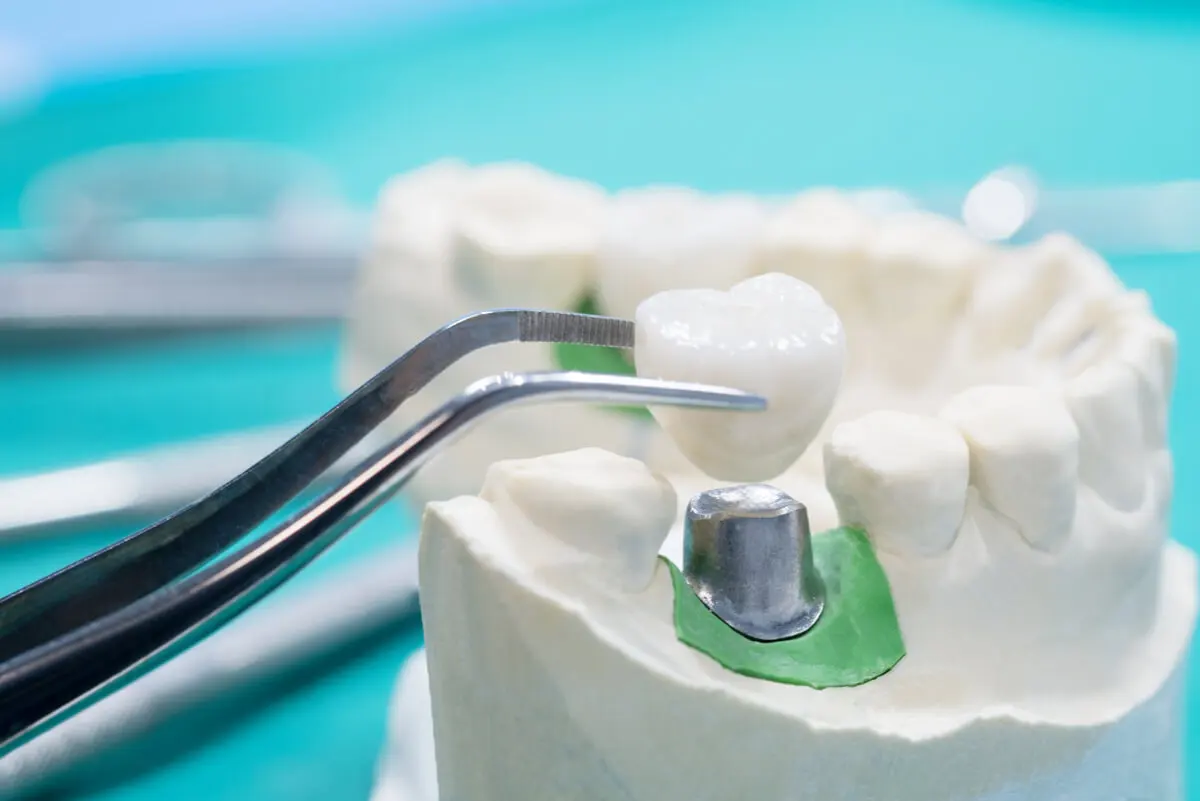What Are Dental Implants and What Are They Used For?

Dental implants are one of the most used options and with the best results to resolve a lack of teeth in the mouth. During this type of treatment, it’s common for dentists to use prosthetic attachments, which are key pieces to recover the smile.
Treatment with implants consists of placing a screw inside the bone that’s integrated into this tissue. This stem in the bone thickness acts as an artificial root that holds the prosthesis and replaces the missing teeth.
Prosthetic attachments are lesser-known components that are part of this process of recovering lost teeth. They’re pieces that connect the prosthesis to the implants to provide stability and security to the whole treatment.
What are prosthetic attachments?
Prosthetic attachments are the devices that join the dental implant to the different structures that make up the prosthesis. Their main function is to fix, retain, and stabilize the prosthetic portion to the bone screw.
They’re pieces designed and manufactured in a very meticulous and precise way so that they can adapt exactly to the surfaces of the implant and the prosthesis. These small structures complete the rehabilitation with the implant and give stability and firmness to the entire prosthetic complex.
As we will see in detail later on in this article, there are different types of prosthetic attachments that fulfill different functions. In any case, these devices must meet certain requirements to guarantee their functionality:
- Good sealing: Prosthetic attachments should adequately seal the interface between the implant and the prosthesis. This prevents the filtration of external agents that could jeopardize the entire treatment.
- Retention and adaptability: The devices used must adapt to the shape of the implant and prosthetic restoration and remain attached to both surfaces.
- Inalterable: The passage of time, the use of rehabilitation and external agents, such as trauma or food substances, should not alter or modify them.
- Stability: The prosthetic attachments must be firmly attached to the implant and prosthesis, thus preventing any type of movement that could destabilize the rehabilitation and generate future problems.

Types of dental implants
There are different types of prosthetic attachments that are used for different functions. Their design and timing depend on their use. These are the most common prosthetic attachments:
- Cap or closing cap: This is a device in the shape of a small cap that is screwed onto the recently placed implant in the area where the supports will be placed. Its function is to prevent the screw from being covered by bone and gum and to prevent external agents from entering the operated area.
- Healing supports: These are small abutments that are screwed to the implant, protruding over the gum ridge. These prosthetic attachments allow the soft tissues to heal around them, generating an adequate biological space to place the prosthesis. In general, they’re usually placed when the implant is already osseointegrated.
- Definitive prosthetic abutments: These are devices that are placed over the implant to allow access from the oral cavity at the time of screwing or cementing the prosthetic rehabilitation. They can be made of metal or ceramic and are placed once the gum has healed, although some authors suggest placing them in the same surgery that the screw is inserted into the bone to prevent connections and disconnections that could affect the tissues.
- Transfers or transfer copings: These are stainless steel or plastic elements that are conical or square in shape and are screwed to the implant when it’s necessary to take an impression of the area. This makes it possible to send the exact position of the implant to the laboratory.
- Analog: This is a device that allows replicating the implant or the abutment in a plaster model in order to send it to the laboratory and facilitate its manipulation. It indicates the exact position of the implant in the patient’s mouth.
- Pass-through prosthetic screw: This is a very small screw that’s fixed to the prosthetic abutment attached to the implant. This screw is used to adjust the prosthetic rehabilitation.
We think you may be interested in reading this, too: Seven Home Remedies for Removing Plaque From Your Teeth
The materials that dental implants are commonly made from
Dental implants that are placed inside the bone are generally made of titanium. This biocompatible material is the material that facilitates the integration of the screw with the bone tissue, giving the prosthesis the desired fixation and stability.
On the other hand, prostheses or crowns that replace missing teeth can be made of various materials. They’re made of metal, zirconium, porcelain, resin, or a combination of some of these. The material chosen will depend on the area of the mouth to be rehabilitated, the patient’s needs, preferences, and possibilities.
Prosthetic attachments can also be made of different materials. In this case, the composition of the device depends on its function in the treatment.
Many prosthetic attachments are made of titanium, especially abutments and caps. This is a material that combines biocompatibility, strength, and lightweight with high durability and strength.
However, there are other materials that can also be used to make implant attachments. There are surgical grade stainless steel, cast gold, zirconium and polyether-ether ether-ketone (PEEK).
How to take care of your dental implants
After the surgery in which the implant is inserted inside the bone, the gums take about 2 to 4 weeks to heal. During this time, it’s important to follow your surgeon’s advice regarding food and proper oral hygiene.
In general, soft diets that prevent a great masticatory effort are best. Cold is a great ally when it comes to reducing tissue swelling, so consuming cold food after surgery will accelerate healing.
Proper oral hygiene prevents infections and promotes tissue recovery. For this reason, tooth brushing shouldn’t be suspended or neglected.
In the surgical area, brushing should be done with more care and caution, using a soft brush or special instruments for this purpose. In addition, if the dentist considers it appropriate, he/she may indicate the use of antiseptic gels or liquids to sanitize the mouth better.
It’s crucial to follow the indications of the professional to prevent complications or infections that affect the healing and the success of the intervention. Once the implants are in place in the mouth, the dentist will place the various prosthetic attachments and tell you how to continue with your treatment.
The dentist will do this at different times, depending on the stage of the rehabilitation process.
In any case, the same care must be taken with regard to food and dental hygiene. If your mouth is kept clean, the risks of complications are much lower.

When densits place a prosthesis
When the implants have integrated with the bone and the gums have healed and healed around the abutments, it’s time to finalize the treatment by placing the definitive prosthesis. Model making, lab work, and mouth try-ins may require a few weeks and several office visits.
First, impressions are taken of the mouth, including the teeth and implants with their abutments. The patient’s bite is also recorded to see how the upper teeth connect to the lower teeth. Thus, models are obtained that exactly replicate the patient’s oral cavity; the new prosthesis is then fabricated based on these models.
When the laboratory finishing making the prosthesis, some adjustments are made so that the new artificial denture fits properly in the oral cavity. The aim is to make it look natural and beautiful, but also to ensure that it’s comfortable and doesn’t damage the other structures.
The corresponding prosthetic attachments are used to place the prosthesis definitively on the implants. The patient will then be able to enjoy his or her new teeth.
This entire process can be performed on one or more missing teeth. In fact, if the patient is missing several teeth, prosthetic alternatives can be used to replace them simultaneously.
Like this article? You may also like to read: 3 DIY Treatments to Remove Tartar from Your Teeth
A fundamental part of treatment
Having a healthy, attractive, and long-lasting smile is possible with dental implants. Knowing what the treatment consists of in detail will help you make an informed decision when it comes to restoring your smile.
Prosthetic attachments are the least-known structures of dental implant treatments. However, their lack of popularity doesn’t make them any less important.
In fact, they’re the key and fundamental connection for the screws in the bone to hold the artificial teeth. So, now you know why these small devices are so necessary to achieve the healthy and beautiful smile you desire!
All cited sources were thoroughly reviewed by our team to ensure their quality, reliability, currency, and validity. The bibliography of this article was considered reliable and of academic or scientific accuracy.
- Padilla-Avalos, C. A., & Marroquín-Soto, C. (2021). Intermediarios protésicos en implantología oral. Revisión de la literatura. Revista Científica Odontológica, 9(2), e064-e064.
- Luque Millán, F. J., Ortiz García, I., Matos Garrido, N., Jiménez Guerra, A., España López, A., & Velasco Ortega, E. (2018). La evaluación topográfica de las superficies de los implantes de titanio. Avances en Odontoestomatología, 34(3), 121-129.
- Blanco López, P., Monsalve Guil, L., Matos Garrido, N., Moreno Muñoz, J., Nuñez Márquez, E., & Velasco Ortega, E. (2018). La oseointegración de implantes de titanio con diferentes superficies rugosas. Avances en odontoestomatología, 34(3), 141-149.
- Belloni, F. (2021). Análisis de fatiga y flexión sobre implantes monoblock de PEEK y la unión pilar PEEK-implante de titanio (Doctoral dissertation, Universidad Nacional de La Plata).
- Arellano Martínez, J. F., & ARELLANO MARTINEZ, J. F. (2021). Interfaz del cuerpo del implante dental y aditamento protésico.
- Sevilla García, R. M. (2020). Conexión y desconexión de los aditamentos protésicos.¿ Cómo afectan a tejidos blandos y duros?.
- Canullo, L., Tallarico, M., Gracis, S., Nebot, X. V., Ciurana, X. R., & Covani, U. (2020). Consideraciones clínicas sobre las estrategias que evitan múltiples conexiones y desconexiones de los pilares sobre implantes. Quintessence: Publicación internacional de odontología, 8(6), 400-409.
- Nicolás-Silvente, A. I., Rivas-Pérez, A., García-López, R., Alemán-Marín, J., Chiva-García, F., & Sánchez-Pérez, A. (2020). La utilización de pilares transmucosos definitivos de colocación inmediata. Avances en Odontoestomatología, 36(2), 99-106.
- Ortega-Martínez, J., i Planell, A. R., Salazar, R. C., & Monné, J. B. (2020). Pilares protésicos intermedios sobre implante y su influencia en el pronóstico de los tejidos peri-implantarios: Una revisión bibliográfica. RCOE: Revista del Ilustre Consejo General de Colegios de Odontólogos y Estomatólogos de España, 25(1), 136-144.
This text is provided for informational purposes only and does not replace consultation with a professional. If in doubt, consult your specialist.








